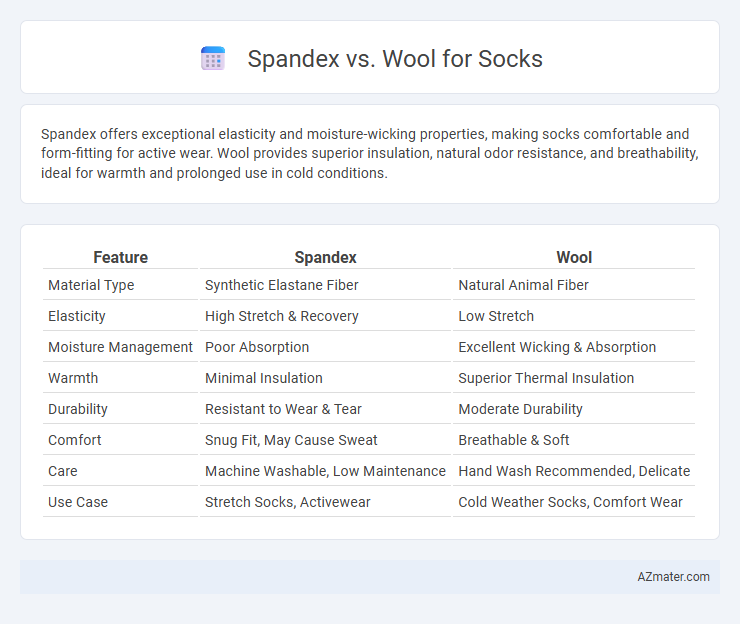Spandex offers exceptional elasticity and moisture-wicking properties, making socks comfortable and form-fitting for active wear. Wool provides superior insulation, natural odor resistance, and breathability, ideal for warmth and prolonged use in cold conditions.
Table of Comparison
| Feature | Spandex | Wool |
|---|---|---|
| Material Type | Synthetic Elastane Fiber | Natural Animal Fiber |
| Elasticity | High Stretch & Recovery | Low Stretch |
| Moisture Management | Poor Absorption | Excellent Wicking & Absorption |
| Warmth | Minimal Insulation | Superior Thermal Insulation |
| Durability | Resistant to Wear & Tear | Moderate Durability |
| Comfort | Snug Fit, May Cause Sweat | Breathable & Soft |
| Care | Machine Washable, Low Maintenance | Hand Wash Recommended, Delicate |
| Use Case | Stretch Socks, Activewear | Cold Weather Socks, Comfort Wear |
Introduction to Spandex and Wool Socks
Spandex socks offer exceptional elasticity and durability, making them ideal for form-fitting and moisture-wicking performance. Wool socks provide natural insulation, breathability, and odor resistance, suited for warmth and comfort in various climates. Choosing between spandex and wool depends on desired flexibility and thermal properties for sock performance.
Material Composition: Spandex vs Wool
Spandex offers exceptional elasticity and durability, making it ideal for socks that require consistent stretch and shape retention. Wool, derived from animal fibers, provides superior moisture-wicking, insulation, and breathability, enhancing comfort and warmth in different climates. Combining spandex with wool in sock material composition balances flexibility and thermal regulation, delivering both support and natural temperature control.
Comfort and Fit Comparison
Spandex offers exceptional elasticity, ensuring socks maintain a snug fit that adapts to various foot shapes without causing tightness or discomfort. Wool provides natural breathability and moisture-wicking properties, enhancing comfort by regulating temperature and keeping feet dry throughout the day. Combining wool's softness and temperature control with spandex's stretchability results in socks that deliver both superior comfort and optimal fit.
Moisture-Wicking and Breathability
Spandex offers excellent elasticity and shape retention in socks but lacks moisture-wicking properties compared to wool. Wool fibers naturally wick moisture away from the skin and provide superior breathability, helping to regulate temperature and keep feet dry. Combining wool with a small percentage of spandex creates socks that maximize comfort by balancing moisture control and flexible fit.
Durability and Longevity
Spandex offers exceptional elasticity and retains its shape over time, making socks highly durable during intense physical activities. Wool, especially merino wool, provides natural resistance to wear and tear while offering moisture-wicking properties that prevent fiber degradation. Combining wool with a small percentage of spandex enhances both durability and longevity, ensuring socks maintain comfort and functionality after repeated use.
Warmth and Insulation Levels
Wool socks provide superior warmth and insulation due to their natural crimped fibers that trap heat and wick moisture away, making them ideal for cold and wet conditions. Spandex, while not inherently warm, enhances sock elasticity and fit, ensuring better heat retention by minimizing air gaps. Combining wool with spandex creates socks that maintain insulation efficiency while offering durability and comfort.
Odor Control Properties
Spandex offers limited odor control properties compared to wool, as it primarily provides elasticity without antimicrobial features. Wool contains lanolin, a natural fiber that resists bacteria growth and effectively neutralizes odor, making it ideal for sock odor control. Merino wool, in particular, excels in moisture-wicking and breathability, further reducing odor buildup during extended wear.
Maintenance and Care Instructions
Spandex socks require gentle washing in cold water and air drying to maintain elasticity and prevent fabric damage, avoiding high heat which can break down fibers. Wool socks need careful hand washing or machine washing on a wool cycle with mild detergent, and drying flat to prevent shrinkage and maintain softness. Proper storage in a cool, dry place helps preserve the durability and performance of both spandex and wool socks.
Best Uses: Athletic, Casual, Outdoor
Spandex socks excel in athletic settings due to their superior elasticity, moisture-wicking properties, and ability to maintain a snug fit during intense physical activity. Wool socks are ideal for outdoor use, offering excellent insulation, natural moisture regulation, and durability in variable weather conditions. For casual wear, wool provides comfort and breathability, while spandex-enhanced socks ensure flexibility and all-day comfort.
Conclusion: Choosing the Right Sock Material
Spandex offers superior elasticity and durability, making socks ideal for athletic or high-movement activities, while wool provides excellent insulation, moisture-wicking, and natural odor resistance, perfect for cold weather and everyday comfort. Selecting between spandex and wool socks depends on whether flexibility and fit or warmth and breathability are the primary requirements. Combining spandex with wool blends can optimize performance by enhancing stretchability without sacrificing thermal regulation.

Infographic: Spandex vs Wool for Sock
 azmater.com
azmater.com